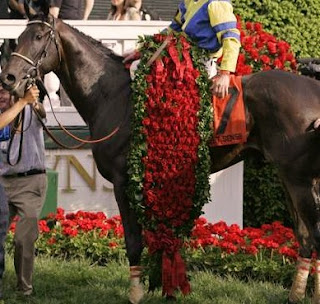Fashion (whether high or noteworthy) is as synonymous with the Kentucky Derby as mint juleps, My Old Kentucky Home, and the horse race itself. Meriweather Lewis Clark Jr., founder of the Kentucky Derby, established the Kentucky Derby dress code of "full morning dress" from the beginning. Men wore full suits with hats, and women wore suits or dresses, gloves, and hats. Mr. Clark Jr. had classy women attend the first Derby to encourage other high-fashion men and women to come as well.
Though fashion changed throughout the decades, modest hats and clothing were part of Derby attire until the 1960s. When television coverage of the Derby became more prominent, and as the fashion mores of the 1960s changed, so did the dress code. The bigger and bolder the hat, the better, so it seemed. During the last two decades of the 20th century, gloves became passe, and more casual attire, like shorts and sundresses, became acceptable in the infield.
After the wedding of Prince William to Kate Middleton in 2011, the fascinator, a head accessory that is smaller than a hat, became popular.
Men and women don stylish or outlandish hats and clothing now, and, as the Lexington Herald-Leader reported in the Weekender section of the April 27, 2018 edition, one will see a variety of apparel, particularly in the infield, at the Derby.
We will leave you with images of Derby fashion from the 1920s to today.
1920s
 |
| https://www.kentuckyderby.com/history/fashion/1920s |
1950s
 |
| https://www.kentuckyderby.com/history/fashion/1950s |
1970s-1980s
 |
| https://www.kentuckyderby.com/history/fashion/1970s |
2000s
 |
| http://www.businessinsider.com/vintage-photos-of-the-kentucky-derby-2017-5#singer-macy-gray-wore-a-bright-pink-hat-to-the-2004-races--25 |
2010s
_________________________________________________________________________________
Sources:
Almanza, A. (2017, May 20). Facinators: The Hair Accessories' Perplexing History. Retrieved from: https://www.allure.com/story/history-of-fascinators
Jacobs, S. (2017, May 6). Vintage photos show the glamour and style of the Kentucky Derby. Retrieved from: http://www.businessinsider.com/vintage-photos-of-the-kentucky-derby-2017-5#even-in-the-1950s-the-derby-was-a-place-to-be-seen-here-the-new-orleans-restaurateur-known-as-diamond-jim-moran-gets-his-diamond-studded-toupee-adjusted-by-a-beautician-before-taking-off-for-the-kentucky-derby-he-was-reportedly-paid-50000-just-to-make-an-appearance-5
Kentucky Derby. (2018). Hats. Retrieved from: https://www.kentuckyderby.com/history/traditions/hats
Patton, J. (2018, April 27). Kicking the Derby off the Bucket List?
Lexington Herald-Leader: Weekender. 12C-13C.















































